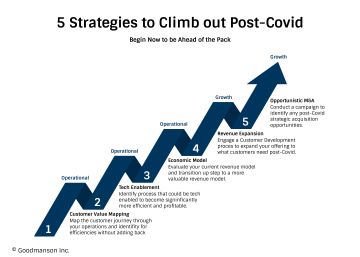In a survey of hundreds of Entrepreneurs, Investment Bankers/Business Brokers and Private Equity firms each was asked, “What do you think makes the biggest impact to a company’s valuation?” People on the ‘sell side’ (Entrepreneurs and Business Brokers) listed Revenue, Growth and/or Profit as the top value creator. Yet, those on the ‘buy side’ (Private Equity firms and Strategics) picked something else first as the top valuation creator. Why?
Entrepreneurs and Business Brokers focus on Growth, Earnings and Revenue because they think about maximizing the company’s value based on their perspective. Meaning, how can I increase what my company is worth for me. And this makes a lot of sense if you have a lifestyle business or no intention of ever selling. These three all work together to build a cash machine, but even though they do create real value for the buyer too, they only tell part of the story and cause many entrepreneurs to focus on the wrong things when it comes to maximizing the value of their business if they ever seek an exit or liquidity opportunity.
On the flip side, what did Private Equity firms and buyers rate as top valuation creator? A clear Competitive Advantage. Why is this more valuable? Because Competitive Advantage drives Growth, Revenue and Profit. It is the cause of the Cause/Effect relationship. That means Growth, Revenue and Profit are lagging indicators if you have a competitive advantage. The more you focus on expanding your advantage the better your results will be.
Further, if you want to maximize the value of your company, focus on how you can increase what your company is worth to the buyer. This means thinking about who would be a potential buyer and the Post-Acquisition Economics, or what your company would be worth to them after they buy it. Certainly, a lot of that upside in value creation should go to the buyer because they are able to get more value out of it than you can, but I’ve seen buyers increase their offer when they have a believable upside and know they can disproportionately win with your competitive advantage. Often, their playbooks in the acquisition is to scale your sales and marketing to rapidly grow the business, they just need to make sure a clear competitive advantage is in place to maximize their outcome.
Sadly, the vast majority of the strategy clients I’ve worked with were not able to clearly articulate any clear competitive advantage for their business. And if it’s the most important thing, this is something you need to know. Even if you aren’t looking to sell it still drives rapid growth, profit and revenue because with this advantage you should win a greater % of deals, have pricing power and therefore a better margins.
How do you know if you have competitive advantage? Here are 3 tests:
#1 The 10x Test (aka the Ben Horowitz Test) Ben, renowned venture capitalist at firm Andreessen Horowitz says:
“The primary thing that any technology startup must do is build a product that’s at least 10 times better at doing something than the current prevailing way of doing that thing. Two or three times better will not be good enough to get people to switch to the new thing fast enough or in large enough volume to matter.”
Where do you land on this test? To determine this, look at the recent deals you’ve had. Are they switching to your product from their current solution? Are they looking at several offerings yet you win a disproportionate amount of these deals? Especially examine deals where you have competition, if you have an advantage the competition can not duplicate it and the buyer should see it as real value and select your firm disproportionately. What percentage of competitive situations do you close? If you know they have the Budget, have the buying Authority, the Need and a clear Timeline to to make a decision (BANT) do you win? This conversion rate proves your advantage when they switch or select your offering. If you don’t know some of these close rates and win % in competitive sales situations I recommend you do a Win/Loss Analysis on deals to learn where you stand.
#2 The Break Through the Noise Test. Secondly, look at leads who are not actively seeking your offering. Focus on what I call the Marketing Lowest Common Denominator (MLCD).
The Marketing Lowest Common Denominator (MLCD) is One Message to One Prospect Not Actively Seeking Your Solution that Generates One Qualified Sales Opportunity.
To find out if you have Competitive Advantage, focus on your MLCD message conversion metrics in the 80% of the market not actively shopping and see how many cold leads you are able to generate when you reach out. (I wrote an article on this process called How Sales can be the Key to Greatly Improve your Marketing Results and Growth.)
#3 Painkiller or Vitamin Test. Lastly, when these people become interested, is the focus on the business outcomes and value you create with your competitive advantage or do they focus on price? If I am in massive pain with a migraine, I always take a painkiller, but although I do believe it’s good for me I skip weeks between taking vitamins, even though I have them in my house. Can you quantify your advantage so that it measurably impacts their business, such as “on average our offering increases the number of qualified lead in your sales pipeline by 25%“. The focus should be on buying the pain relief (critical business outcome) not the features of the pill (features, demo requests to look at it, etc).
Conclusion
As a business owner it is critical to know your competitive advantage and it drives your growth, revenue and profit. I recommend everyone use the above tests to know if you have a Competitive Advantage, especially if you want to sell your business one day. People who look at buying your company know that if you solve real pain and have a competitive advantage your company is more valuable. Bottom line, a Competitive Advantage is key to any business that wants to grow.
How do you identify your Competitive Advantage? I’d love your thoughts. Next, I will write up the process I’ve used to identify or pick a clear competitive advantage.
Valuation Impact Source: Exits & Acquisitions 2019 Entrepreneur Selling a Company Survey.


